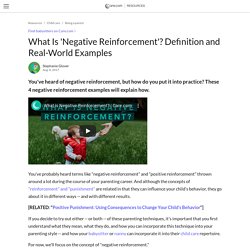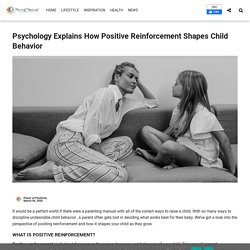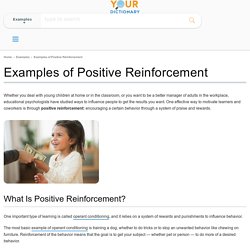

Learning based on consequences. Skinner’s Operant Conditioning: Rewards & Punishments. What Is 'negative Reinforcement'? Definition And Real-World Examples. You've heard of negative reinforcement, but how do you put it into practice?

These 4 negative reinforcement examples will explain how. You've probably heard terms like "negative reinforcement" and "positive reinforcement" thrown around a lot during the course of your parenting career.
Psychology Explains How Positive Reinforcement Shapes Child Behavior. <img height="1" width="1" style="display:none;" alt="" src=" /> <img height="1" width="1" style="display:none;" alt="" src=" /> <img height="1" width="1" style="display:none;" alt="" src=" /> <img height="1" width="1" style="display:none;" alt="" src=" />

Examples of Positive Reinforcement. Whether you deal with young children at home or in the classroom, or you want to be a better manager of adults in the workplace, educational psychologists have studied ways to influence people to get the results you want.

One effective way to motivate learners and coworkers is through positive reinforcement: encouraging a certain behavior through a system of praise and rewards. What Is Positive Reinforcement? One important type of learning is called operant conditioning, and it relies on a system of rewards and punishments to influence behavior. The most basic example of operant conditioning is training a dog, whether to do tricks or to stop an unwanted behavior like chewing on furniture. Negative Reinforcement: What Is It and How Does It Work?
What is negative reinforcement?

Negative reinforcement is a method that can be used to help teach specific behaviors. With negative reinforcement, something uncomfortable or otherwise unpleasant is taken away in response to a stimulus. Over time, the target behavior should increase with the expectation that the unpleasant thing will be taken away. Read on to learn more about this type of learning. Examples of Negative Reinforcement. It helps to explore some examples of negative reinforcement, a concept of operant conditioning that people frequently misunderstand.

Learn what negative reinforcement is and see how it works in practice. What Negative Reinforcement Is and Is Not Negative reinforcement is about encouragement. The American Psychological Association (APA) reports that it has to do with removing a negative or unpleasant stimulus from a situation in response to someone's action. Because the negative stimulus is removed, the person or animal wants to keep doing the action that removed it.
Positive and negative punishment. Positive and Negative Punishment. What is Negative Punishment (Examples and Effectiveness) In this article, we will review negative punishment, its definition, examples, and drawbacks.

American psychologist B.F. Skinner developed the theory of operant conditioning, which stated that a person or animal’s behavior could be increased or decreased by adding or removing appropriate stimuli after the behavior is exhibited. The difference between classical conditioning and operant conditioning is that classical affects unconscious behavior, while operant affects conscious behavior. Within operant, punishment aims to reduce a behavior while reinforcement increase a behavior. Punishment or reinforcement can be positive or negative. Difference Between Positive and Negative Punishment.
10 Most Common Problems Teens Face in 2021 - Parentology. 10 Normal Teenage Behavior Problems And How To Handle Them. Understanding Teenage Behavior Problems Dealing with a teenager is not easy.

No matter how good a parent you are, and how great your relationship with your children is, you are likely to face parenting roadblocks when it comes to your teenager. Behavior problems are common in teenagers. But you can deal with them with ease if you are willing to put in the effort to understand what they are going through and what it is that they need from you. Help for Parents of Troubled Teens.
Teen issues Is your teenager violent, depressed, abusing alcohol or drugs, or facing other problems?

Here’s how to ease the stress at home and help your teen transition into a happy, successful adult.
Negative Reinforcement. Positive Punishment. Negative Punishment.